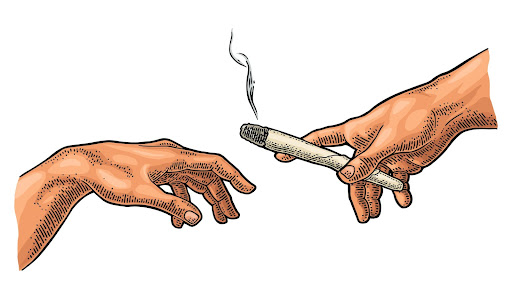
Today, more than 200 million people regularly smoke cannabis, making it one of the world’s most popular recreational drugs. But long before we could walk into a dispensary for a fix, ancient civilizations were using cannabis as a way to heal, feed, clothe, and house themselves.
Though we have an extensive symbiotic relationship with cannabis, the evolution of the plant precedes humans by millions of years. Pollen studies estimate the plant evolved 28 million years ago on the eastern Tibetan Plateau, where it still grows wild today. To put that in perspective, homo sapiens likely evolved around 300,0000 years ago.
Despite this gap in history, early humans were quick to learn about cannabis’ wonders with the first recorded use dating back to 8000 BC in an ancient Taiwan village. There, the Taiwanese learned to spin hemp fibers, relinquishing the need to rely on animal skin for clothing. Soon after, hemp became the material of choice due to its sturdy nature, widespread availability, and affordability.
As time progressed, so did the usage of cannabis. We now know that hemp was farmed as a food crop as early as 4,000 BC. During the Stone Age, it was even considered to be one of the “five grains” of China.
Medicine for the gods
Fast forward to 2800 BC and there is documented evidence of cannabis being used medicinally. Emperor Shen Nung, regarded as the father of Chinese medicine, listed cannabis as one of the 365 medicines in the first-ever pharmacopeia. In it, he writes that it can be used to treat over 100 different health ailments, including gout, malaria, and rheumatism. In other words, cannabis was being used to treat inflammation and pain. These same benefits were echoed in texts recovered from Indian Hindus, Assyrians, Greeks, and Romans in the following centuries.
Most notably was the use of cannabis in religious texts. In the Vedas, for example, written between 2000 BC and 1400 BC, cannabis was described as a “source of happiness” and “bringer of freedom.” These texts say cannabis was given to humans by the gods as a way to “achieve delight,” which suggests the first-ever recreational use of the plant – though we do not have physical evidence.
Cannabis’ connection is so intertwined into Hinduism that it is actually named one of the five most sacred plants in the Atharva Veda. One Hindu legend suggests that the onset of fever was the ‘hot breath of the gods’ who were angered by the afflicted person’s behavior. Using cannabis appeased the gods, hence reducing fever. We now know an alternative explanation, of course – THC acts on the hypothalamus to reduce body temperature. (Though, we aren’t ruling out the appraisal of gods.)
A taste for the high life
Though we have evidence of our ancestors using cannabis in all forms, it wasn’t until recently when we discovered that they had the intention of getting high. Previously, early cultivation of cannabis targeted the oily seeds for food, long stem cells for fiber and clothing, and the rest was used as medicine.
Compared to cannabis in dispensaries, wild cannabis does not contain high levels of THC – the psychoactive chemical that gets us high. Even more so, chemical analysis of ritual cannabis use prior to the recent findings indicated low levels of THC, meaning our ancestors likely weren’t getting the plant’s psychoactive effects.
This changed, however, when researchers found artifacts in the remote Pamir mountains in western China. Around 70 artifacts dating back to 500 B.C. were retrieved from a burial site, including glass beads, harps, pieces of silk, and wooden bowls and plates. Cuts and perforations in some of the skulls and bones suggest human sacrifice.
Interestingly enough, that’s not what shocked the researchers. Instead, what really surprised them was the phytochemical analysis – which showed high levels of THC inside the wooden bowls.
Given the hints of ritual use, along with the recovered text of what we do know, researchers have been able to piece together a likely story.
“We can start to piece together an image of funerary rites that included flames, rhythmic music, and hallucinogenic smoke, all intended to guide people into an altered state of mind,” states the study.
This landmark discovery now gives us a peek into the lives of early humans and a deeper understanding of our relationship to cannabis.
They also found that the wooden bowls showed characteristics of “prolonged use as a mortar,” signaling to researchers that the plant was likely pulverized before consumption. Some theorize this means the psychoactive plant could have been consumed orally – which, if that’s the case, we’re thankful for having much tastier options today.
